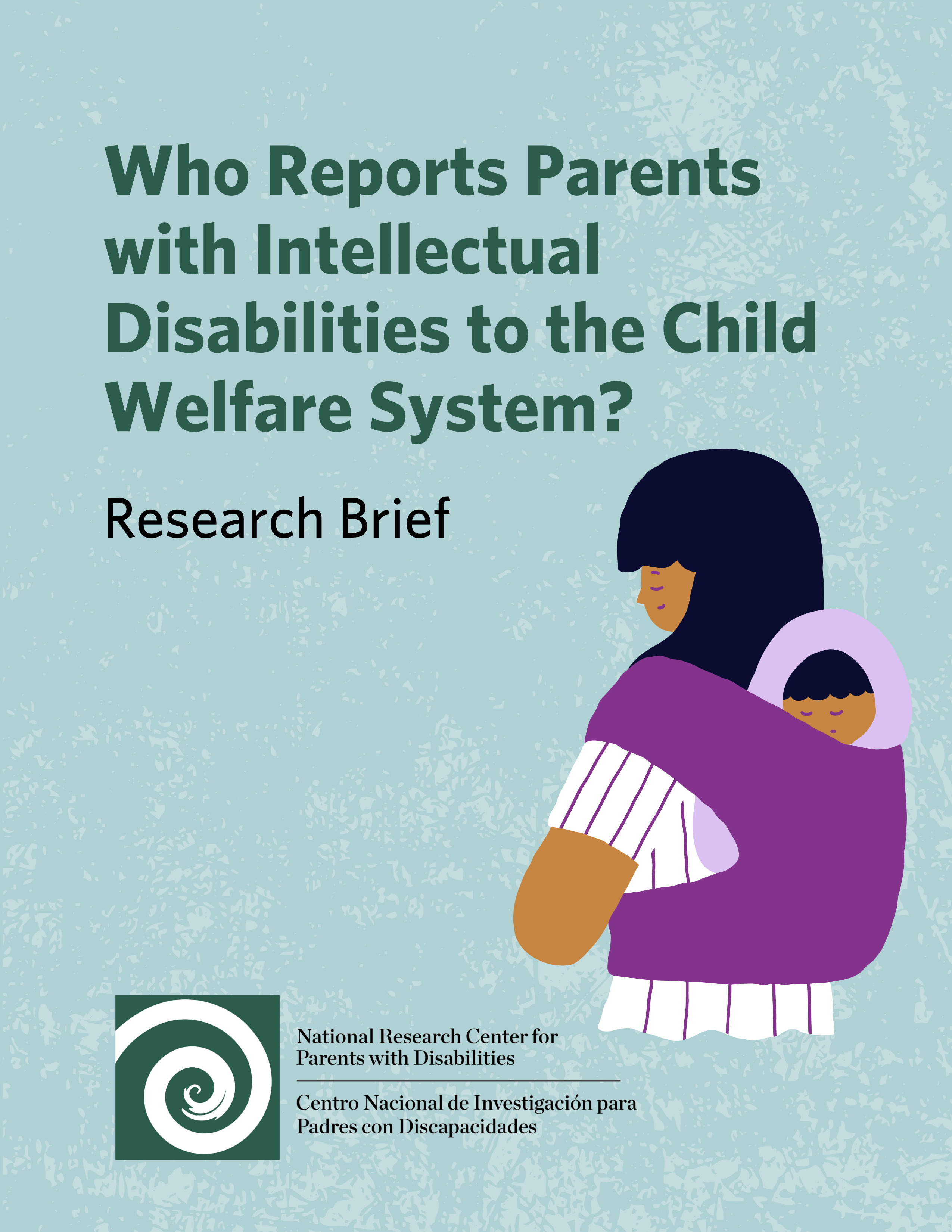Who Reports Parents with Intellectual Disabilities to the Child Welfare System?
By Sharyn DeZelar and Elizabeth Lightfoot · November 2021
Introduction
Compared with parents without disabilities, disabled parents—and parents with intellectual disabilities in particular—are reported to the child welfare system at higher rates. Parents with disabilities aren’t just reported to the child welfare system at higher rates: once reported, cases of abuse or neglect are more  likely to be substantiated. Cases of child abuse or neglect are substantiated when child welfare workers determine that a reported case should be investigated. If cases of abuse or neglect are substantiated, parents with disabilities risk having their children removed from their homes, losing custody or visitation rights, and encountering other adverse outcomes.
likely to be substantiated. Cases of child abuse or neglect are substantiated when child welfare workers determine that a reported case should be investigated. If cases of abuse or neglect are substantiated, parents with disabilities risk having their children removed from their homes, losing custody or visitation rights, and encountering other adverse outcomes.
We can explain this disparity in two ways: first, because people with disabilities often need extensive medical and social support, parents with disabilities are more likely to interact with professionals, such as doctors, case managers, and social workers, all of whom might refer them to the child welfare system. This phenomenon is called “exposure bias.” Second, the child welfare system routinely discriminates against parents with disabilities under the misconception that if parents have disabilities, they must be unfit parents just because of their disability. Because of this bias, child welfare workers and other professionals are more likely to report possible cases of abuse and neglect. These inequities are compounded by a lack of appropriate interventions for parents with disabilities, as well as assessment practices that don’t consider parents’ access needs.
To learn how parents with intellectual disabilities become involved with the child protection system, Elizabeth Lightfoot and Sharyn DeZelar conducted a study to learn…
- who is making these reports to the child welfare system, and
- whether substantiation rates for parents and caregivers with intellectual disabilities vary depending on who referred them to the child welfare system. These referral sources include lawyers, teachers, social workers, relatives, medical professionals, co-parents, and relatives.
Findings
The top eight referral sources for parents with intellectual disabilities were (1) law and legal professionals (16%), (2) educational professionals (15%), (3) social service professionals (15%), (4) medical professionals (10%), (5) anonymous sources (9%), (6) other relatives (9%), (7) other sources (9%), and (8) friends (6%).
For parents with other disabilities, the top eight sources were (1) law and legal professionals (18%), (2) social service professionals (16%), (3) education professionals (14%), (4) other relatives (9%), (5) anonymous sources (9%), (6) medical professionals (8%), (7) a parent (7%), and (8) other sources (7%).
Lightfoot and DeZelar found that, compared with nondisabled parents, parents with disabilities were more likely to be referred to the child welfare system by social service providers. This finding supports the exposure-bias theory, since parents with disabilities are more likely to interact with these providers than nondisabled parents. The exposure-bias effect was especially strong for parents with intellectual disabilities, whose chances of being referred to the child welfare system by substitute care providers were higher than those of parents with other disabilities. Substitute care providers—including foster parents and relatives—are noncustodial adults who care for children temporarily.
In general, disabled parents were more likely to have their cases substantiated than parents without disabilities, possibly because of systemic bias against parents with disabilities and misconceptions about their ability to raise children well.
For all report sources except for childcare and foster care providers, reports on caregivers with intellectual disabilities had a higher chance of being substantiated.
Policy Implications
Because social service professionals report parents with disabilities at high rates, researchers must learn more about the experiences, characteristics, and needs of these professionals to develop training that counters bias against parents with disabilities. Training for professionals should include information about…
- exposure bias and the dangers of overreporting parents with disabilities, since parents with disabilities are more likely to interact with medical and social service providers than nondisabled parents;
- the effects of higher referral and substantiation rates on parents with disabilities and their children, since parents with disabilities may delay or cancel appointments for fear of being wrongfully reported to the child welfare system; and
- the persistent bias against people with disabilities and their ability to raise children successfully.
Methods
Lightfoot and DeZelar used data from the 2014 National Child Abuse and Neglect Data System (NCANDS), a national database that includes data from child protection service agencies across the United States. NCANDS uses a series of codes to identify caregivers’ disabilities.
Limitations
The database used in the study did not examine the relationship between race and disability. Further research should consider how racism interacts with biases against people with disabilities, as well as the experiences of disabled parents of color. This database also lacked detailed information about parents’ socioeconomic status.
Credit
Adapted by Luca Swinford, Miriam Heyman, and Finn Gardiner from DeZelar, S., & Lightfoot, E. (2020). Who refers parents with intellectual disabilities to the child welfare system? An analysis of referral sources and substantiation. Children and Youth Services Review.
Disclaimer and Funding Statement
The contents of this brief were developed under a grant from the National Institute on Disability, Independent Living, and Rehabilitation Research (NIDILRR grant number 90DPGE0001). NIDILRR is a Center within the Administration for Community Living (ACL), Department of Health and Human Services (HHS). The contents of this brief do not necessarily represent the policy of NIDILRR, ACL, or HHS, and you should not assume endorsement by the Federal Government.
